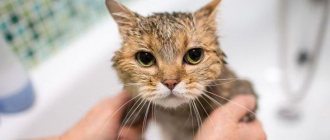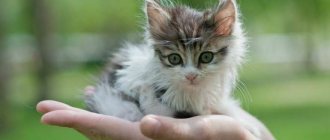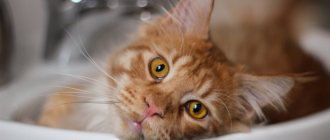To bathe a kitten or not to bathe, and if to bathe, then how? These questions become relevant when the baby is taken away from the cat and brought to a new family. Until this moment, all water procedures for the baby are performed by his mother, diligently licking her own child from the top of the head to the tip of the tail. And now it’s the turn of his new “parents”.
By this time, the kitten will be two months old; it will take some time to get used to the new home, because two stresses “for one spoon” (parting with mom and a bath day) will be too much for the baby to handle. So add about two more weeks to a couple of months - and you can take the mustachioed tabby to the bathroom.
Reasons to bathe a kitten
Does it need to be washed at all? As a rule, yes. After all, anything can happen to a mischievous person. How is the song sung? “And yesterday I climbed into the chimney…” Here is a reason for you to give him a bath for the first time.
The second important reason is that you need to teach the kitten not to be afraid of water. Even if you do not have to bathe your pet often in the future, it is useful if he learns about bathing in infancy: it is much more difficult to accustom an adult cat to water procedures. And if you prefer purebred kittens to ordinary kittens and plan to participate in exhibitions, you will have to wash the cat quite often.
A special situation is when you bring a kitten into the house from the street. Whether abandoned by someone or born in the yard, it (even if it is not two months old) needs to be washed with special products against fleas, fungus, and any parasites.
At what age should I introduce water?
The kitten will remember the first contact with water for a long time, so you need to take the process seriously.
If your pet still has negative emotions, then next time he will fight back hard: scratching, biting and struggling with all his might. That's why you need to turn bathing not only useful, but also a pleasant pastime.
Some breeders claim that a kitten can be washed from the age of one month. This is explained by the fact that such a baby practically does not resist and does not scratch. But it’s not worth risking the baby’s psyche, because any unknown procedure is a great stress for him.
© shutterstock
First swim
The first time is the most important. If you manage to do everything correctly, do not scare the baby, and he feels pleasure from water procedures, you will save yourself from big problems in the future.
The most common mistake is giving a kitten a bath for the first time. Large, with a lot of water, it will certainly frighten the kitten. In addition, it will be very inconvenient for you to wash it at an angle, leaning over the side and putting your hands down. Be sure that as soon as you hesitate for a second, the kitten will “fly up” onto your neck or head, climbing up your arms like up a tree trunk.
The most convenient way to wash your baby is in a basin or sink. You need to put a rubber mat or a small terry towel on the bottom. The water temperature should not be higher than 38 - 40 degrees, the “depth” should not be more than three centimeters.
It will be right if you prepare everything you need in advance: a large fluffy towel, shampoo, a bowl of water. If you have to wash the kitten alone (although it would be more convenient for two), unscrew the cap on the shampoo in advance. Prepare a couple of cotton balls soaked in sunflower oil to plug your baby's ears with, otherwise water may get into them. By the way, protect your eyes by smearing their corners with Vaseline oil.
Are you prepared? Now the most important thing is how to bathe a kitten. Take him by the withers with your hand (as the mother cat took him with her teeth) and place him in a basin of water. It doesn’t matter whether he sits or stands on all four legs, the main thing is that his posture is sufficiently stable.
Wash your baby carefully, protecting the head (especially the eyes and ears) from getting water. Do not turn on the shower - strong water pressure can frighten the kitten. Always talk to him in a normal, calm voice.
The bathing procedure should not be too long: shampoo “eats” the grease from the hair, and without it, your pet’s “fur coat” will not be shiny and smooth. There is also a risk of drying out the skin, which will become easy prey for harmful microorganisms and various infections.
After the washing is over, wrap your pet in a towel so that it is comfortable for him to breathe and look around, but under no circumstances wrap him up “with his head.” Hold the baby in your arms for a few minutes to dry him, and then put him down on the sofa - he will clean himself up. You will make sure that there are no drafts and your pet will not catch a cold.
And the last point: praise the baby for being brave and obedient (you can even play a little trick) and reward him with something tasty that he really likes. For pedagogical purposes.
What to do next?
After bathing, the kitten is wrapped in a towel to absorb excess moisture. After a few minutes, the wet towel should be changed. There is no need to rub the little body, just blot it . Next, the wool is dried with a hairdryer, otherwise it will roll up and tangles will remain. In addition, a child who has not reached adulthood can catch a cold and get sick, because even in a warm room, the wool will dry completely only after 10–12 hours.
The scary buzzing device is kept at a distance of 30 cm from the cat. If it is possible to adjust the air supply, then it is better to choose a gentle mode.
At the end, the fur coat is combed out with a brush and the kitten is sure to be offered a favorite treat so that washing is associated with pleasant emotions.
Bathing products used
You cannot bathe a kitten with regular human shampoo. The fact is that shampoo for people, including children and even allergy sufferers, may contain substances that are dangerous for a young cat’s body. The baby may be sensitive to even harmless chemicals. You should also not use shampoo-conditioner when caring for kittens.
Shampoo designed for adult cats or other pets (for example, dogs, rabbits, horses) will not be suitable for them either. Sometimes for cowards who are terrified of water, they use so-called dry shampoo or spray shampoo. Their use, unfortunately, is a half-measure, because some tasks are still difficult to complete without water.
For purebred kittens, shampoos are selected especially meticulously.
One is for British blues, another is for Persians, the third is for sphinxes. Buy them in specialized stores, where they can guarantee the quality of the drugs and also give you recommendations on their proper use.
How often to wash
Cats' natural love for cleanliness makes bathing an auxiliary, rather than a primary hygiene procedure. On the contrary, too frequent washing degrades the quality of the fur.
The frequency of washing kittens depends on the breed, coat length, and health status. As a rule, cats are bathed 6 times a year. If the animal does not leave the apartment, bath days are held once a quarter or six months.
Often you can only wash kittens of hairless breeds. They get dirty faster, so they get water treatments about once a month. Show cats are given unscheduled baths before shows.
For your information. If a cat goes outside, be sure to wash its paws after each walk.
Water procedures: economy option
It happens that there is no need to bathe the whole pet, but only certain parts of the body need to be tidied up. Here's how to do it:
- ears are cleaned with cotton pads and a special ear lotion;
- the muzzle - with cotton pads, and the chin - with zoo shampoo;
- butt - with wet wipes;
- nose - with a paper napkin;
- paws (after using the toilet or walking) - with water in the washbasin;
- eyes - with wet disks, and if they are watery - with cotton wool dipped in freshly brewed tea.
What to do with a found kitten when the age is unknown?
There are always a lot of fleas living on the skin of outdoor cats. You should also not rule out lichen, helminthic infestations and other infectious diseases. It is important to take your pet to a veterinarian as soon as possible. Bathing with lichen at any age is not prohibited if the coat is very dirty or the use of special shampoos (Nizoral, Sebozol) is required. In other cases, the infection may spread to healthy areas of the skin.
For a newborn kitten under 2 weeks of age, early bathing can be harmful. It is better to wipe it with a soft sponge soaked in warm water without adding detergents.
Features of washing hairless cats
Cat litter: which options are best to choose
How to bathe a Sphynx kitten and how often should it be done? The fact is that hairless cats get dirty faster than their brothers in fur coats, so they will need bathing much more often. In addition, hairless breeds of cats sweat much more, and a lot of different debris can accumulate in their folds in the form of leftover food, litter, and lint.
It’s difficult to say for sure how many times a month to bathe a hairless pet. On average, this happens every 2-4 weeks, it all depends on its color and degree of contamination.
Bathing hairless cats has its own distinctive features
Typically, the following signs are a signal for water treatments in hairless cats:
- an unpleasant odor began to emanate from the pet;
- the baby's skin has become sticky and oily;
- Dirt is clearly visible in the folds of the skin.
But washing a bald baby too often will also not do him any good, since the special lubricant produced by the sebaceous glands is washed off, and the kitten is thus deprived of natural protection against various pathogens.
Important! Hairless cats are prone to rapid hypothermia after water treatments.
In general, the procedure for the first bath of an ordinary kitten and a small sphinx is not very different. The only difference is that you need to wash a hairless baby with a special soft sponge, carefully treating the fold areas, and use a special shampoo for cats without hair.
At the end of the water procedures, the kitten’s face, ears and back of the head are wiped with special sanitary napkins.
ATTENTION, TEST! Answer a few simple questions and find out what kind of owner you are for your cat:
Does your cat have a name?
How often do you play with your pet?
Do you get your vaccinations and parasite treatment up to date?
Is your kitten spayed/neutered?
What do you feed your purr?
What kind of owner are you for your cat?
Your kitty is very happy
Congratulations! Your purr is healthy and happy, surrounded by care and love. You are a responsible and good owner for your kitty.
Your pussy could be happier
Hmm... with such an owner, even the cockroaches will all die. Maybe you should have gotten a cactus instead of a cat? Yes, you are not the best and most caring owner, but you still have a chance to fix everything. Start taking proper care of your pet.
There is no general consensus on how many times a pet should be bathed per year. When using shampoo, recommendations for the number of times it should be used will be indicated on the packaging.
How to wash representatives of different breeds
Representatives of different breeds require a special approach to bathing:
- Shorthaired Scots and Britons who devote a lot of time to grooming can be bathed once every six months.
- Long-haired cats, such as Persian or Siberian cats, need to be washed every 2 months.
- White kittens are bathed with whitening shampoos.
- Detergents for long-haired breeds are not used for short-haired kittens with abundant undercoat.
- It is not advisable to bathe kittens of white and blue colors, particolors and silver pets with herbal shampoos.
- To wash Sphynxes and other hairless cats, specialized shampoos are used that care for the skin. The head is wiped with sanitary napkins.
- Products for adding volume are not suitable for animals with tight-fitting hair without undercoat (Siamese, Oriental, Abyssinian cats, etc.).
Inventory
Try to avoid bathing the kitten in the bath itself. A large space filled with water will cause stress and panic in the baby. To feel more protected, it is important for a pet to cling to something, but this is impossible to do in the bath.
Therefore, it is recommended to use a basin to wash the kitten.
A sink is also not suitable for these purposes. Firstly, this is dangerous for the kitten, because it will struggle and may fall from a great height, and secondly, it is inconvenient for the owners: splashes will fall on the walls and floor, the owner may slip, and then labor-intensive cleaning of the bathroom awaits him rooms.
To prevent the cat child from running away, it is recommended to attach it to a harness.
In addition, for stubborn kittens, you can purchase a special synthetic bathing bag.
It looks like a large mesh with a special cord that is fixed around the neck. This bag securely holds the pet and protects its owner from sharp claws and teeth. Water and shampoo penetrate well through the mesh cells. This attribute can also be used for other procedures that are unpleasant for the cat, for example, when trimming claws or cleaning ears.
During the bathing process, it is very important not to wet the kitten’s head and carefully avoid getting water into the ears. To do this, you can use cotton pads or purchase a swimming cap. You don’t need a washcloth to wash your animal; washing off dirt from a cat’s coat with your hands is easier, faster and better. In addition, the kitten may be frightened by a foreign object, but it is probably already accustomed to human hands.
Tips for hosts
In addition, it is important to prepare for swimming in advance so that everything you need is at hand. It is advisable to carry out even the preliminary stage in the bathroom behind closed doors.
Claw trimmers and a comb are placed on the dressing table (or shelf).
It is advisable to carry out even the preliminary stage in the bathroom behind closed doors. Claw trimmers and a comb are placed on the dressing table (or shelf).
If the kitten is going to be bathed in the sink, close the drain hole immediately. A basin or bath is installed, but not immediately filled with water. A bucket of warm liquid (covered with a lid) and a small ladle or mug should be kept nearby.
The bottle of detergent should be opened in advance so as not to waste time on this action when the kitten is wet.
If you plan to soap your pet’s fur not with your hand, but with a sponge, place it next to the container in which the animal will be bathed.
2 towels are hung on the hook - one for preliminary drying, and the other for wrapping the kitten after bathing.
Preparatory stage
To avoid scratches on the body, the owner puts on a long-sleeved robe in advance
But this does not exclude such an important step as trimming the claws.
True, breeders recommend performing this procedure in advance - several hours, but it can also be done immediately before the session.
You should not ignore it, as after bathing the matted fur will be difficult to tidy up.
They do not miss any part of the body, paying special attention to tangles
Not all kittens like to be brushed, so after the procedure it is recommended to calm an agitated pet by giving him a treat. Next time, in anticipation of such reward, the kitten will place its back under the comb.
Bathing algorithm
In order for the pet to feel comfortable in the water and not resist, the hygiene procedure should be turned into a kind of ritual with elements of play.
Procedure steps:
- The baby is placed in an empty bath, where his favorite ball already lies. They play with the kitten for a few minutes.
- Without stopping the fun, add a little water to the bath so that only the animal’s feet are in it.
- The pet is stroked with one hand so that it does not worry, and with the other they take a mug, scoop up water from the bucket and water the kitten. He will try to jump out of the bath, so you need to hold him (but without much effort).
- While the assistant, stroking, holds the pet, the owner foams a small amount of shampoo in his hands and applies it to the animal’s fur: they begin the movement from the tail, then wash the hind and front paws, simultaneously grabbing the tummy, neck, move to the back, gradually returning to the tail.
- The foam is washed off by pouring small portions of water over the kitten until the liquid flowing from the pet becomes clear.
The animal's face is not soaped - just wipe it with a damp hand or a wet soft cloth.
Drying
You need to not only be able to wash a kitten, but also dry it properly. It is not recommended to wrap your pet completely in a towel.
Only after this do they take another towel (large, fluffy, dry) and wrap the kitten in it. The owner should sit next to the heat source, placing a small “package” on his lap.
After a few minutes, making sure that all the moisture has been absorbed into the towel, the baby is revealed, not forgetting to reward him for his courage with some tasty treat.
Indications
According to veterinary experts, there is no need to wash the animal unnecessarily. Bathing for most cats and kittens is extremely stressful, so this procedure should be resorted to only when necessary. However, there are reasons that can be considered objective indications for swimming.
The appearance of a kitten
If a kitten comes into the house, taken from a well-groomed domestic cat, then most often there is no need to bathe it.
Small pets adopted from a shelter usually do not require bathing. Employees of such organizations and volunteers, as a rule, give their charges to their new owners clean, neat and combed.
The situation is somewhat different when a kitten picked up on the street appears in the house.
In this case, the animal must be carefully examined, paying special attention to the condition of the ears, eyes, nose, abdomen and groin area.
You should inspect the fur no less carefully, running your fingers against it (you should first put on gloves). The presence of bald spots in the fur may indicate the development of lichen, and the presence of streaks and traces of pus in the area of the nose and eyes may indicate an infectious disease
After examining the pet, you need to carefully bathe it using a special antiparasitic shampoo.
If the cat gets dirty
Although cats and cats are considered clean animals, some of them do not live up to this stereotype at all. Some representatives of the cat family even manage to get dirty while in a clean house, without even leaving its confines.
Some cats' fur can quickly and frequently become dirty, matting into untidy tangles due to increased sebum production. This phenomenon is often observed in animals experiencing hormonal changes. In this case, pets also need to be bathed using a special zoo shampoo with an antiseborrheic effect.
Shedding
The period of intensive change of undercoat is one of the main reasons requiring more frequent bathing. During shedding, some of the dead hair remains and gets tangled in the fur, forming unsightly tangles and lumps. The animal is not able to cope with them on its own. Moreover, while trying to clean itself up, a shedding pet often choke on its own fur. Here it is also necessary to carry out a bath with further thorough combing of the dead undercoat.
Presence of parasites and fleas
The discovery of parasites and fleas in an animal's fur is a reason why a thorough bath should be carried out immediately
During the procedure, it is important to use a special zoo shampoo with an insecticidal effect. Such detergents help destroy parasites and prevent their further appearance.
In some cases, the procedure is repeated.
Preparation for the exhibition
Professional cat breeders know well how much effort it takes to prepare for exhibition events. Before the exhibition, purebred pets are washed using very expensive shampoos, which add shine and volume to the coat. Additionally, the wool is combed and styled with professional gels and varnishes.
The reasons listed above are the main reasons for giving your pet another bath. Veterinarians remind owners of cats and kittens who prefer to wash their animals too often that this can lead to the development of skin diseases, including massive hair loss.











